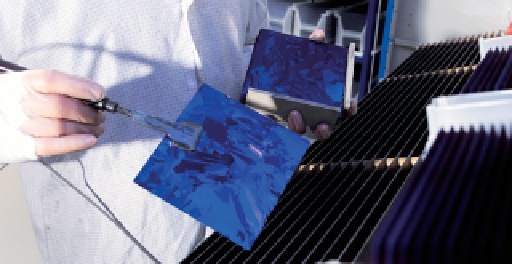Environmental Engineering Reference
In-Depth Information
Figure 5.5
Polycrystalline solar cells with anti-refl ection layers before the front contacts
are applied.
Photo: BSW, www.sunways.de.
this increases the effi ciency of a cell, it is also a more complicated and expensive
way to manufacture cells. The fi nished cells are then fi nally tested and sorted accord-
ing to performance class for further processing into photovoltaic modules.
5.2.2 From Cell to Module
Silicon solar cells are usually square in shape. The length of the edge is measured
in inches. Originally solar cells were typically 4 inches (approx. 10 cm) in length.
In the meantime a measurement of 6 inches (approx. 15 cm) has established itself
as the standard. Some manufacturers are already producing 8-inch (approx. 20 cm)
solar cells. Large solar cells require fewer processing steps to be made into modules.
However, the risk that the cells will break during further processing is also greater.
The current increases with the size of a solar cell, whereas the voltage remains
constant. The electric voltage of a solar cell is only 0.6 to 0.7 volts.
Practical applications clearly require high voltages. Therefore, many cells are inter-
connected in series to form solar modules. The front contacts of a cell are connected
to the back contacts of the next cell using soldered-on wires. It takes 32 to 40 cells
connected in series to produce a suffi ciently high voltage to charge 12-volt batteries.
Higher voltages are needed to feed into the grid through inverters. Solar modules
with an even higher number of cells interconnected in series are available for this
purpose.
Solar cells are very sensitive, break easily and corrode when in contact with mois-
ture, so they must be protected. Consequently, they are imbedded in a layer of
special plastic between the front glass panel and a plastic fi lm on the back (Figure
5.6). Some manufacturers also use glass for the back. The glass provides mechanical
stability and must be very translucent. The plastic material used for imbedding the
solar cells consists of two thin fi lms of ethylene - vinyl - acetate ( EVA ). At tempera-
tures of around 100 ° C these fi lms bond with the cells and the glass. This process
is called lamination. The fi nished laminate then protects the cells from the effects
of the weather, especially moisture.

